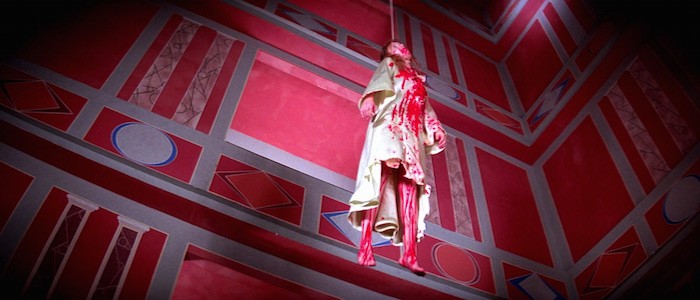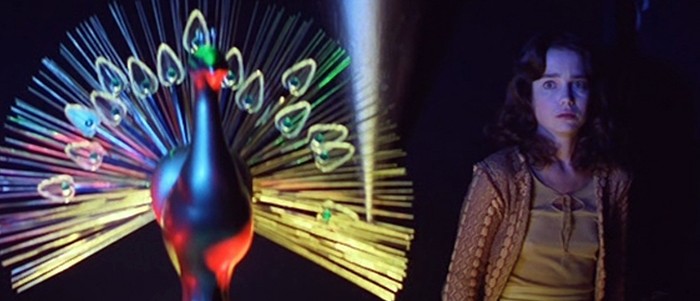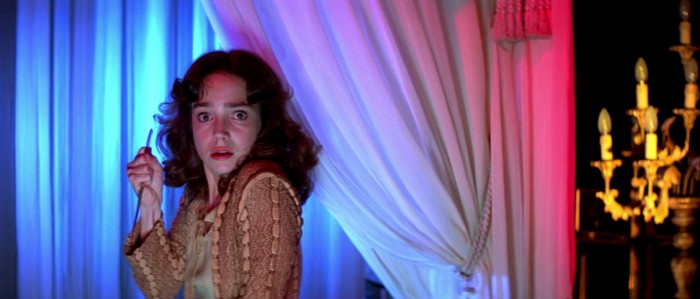The /Film Movie Club: Why 'Suspiria' Is The Craziest, Most Colorful Bad Dream You'll Ever Watch
(Welcome to the /Film Movie Club, a new semi-regular feature where we delve into some of our favorite movies, focusing on films that lie a little off the beaten path. Today: Dario Argento's Suspiria.)
Some movies benefit from being watched at a particular time, in a particular place, while you are in a particular mood. Suspiria, Dario Argento's 1977 horror masterpiece, is a gripping and unsettling experience in any context, but it practically demands to be watched in the dark, on the biggest screen you can access, with the sound cranked up as high as you can bear. Oh, it it helps if you start watching if after midnight, so you're just tired enough to wonder if you're actually seeing what you think you're seeing.
That last part isn't necessary, but when I recently settled in for a late night repertory screening of Suspiria, I found myself instantly battling fatigue. The result: one of the most memorable movie-watching experiences of my life, where Argento's film merged with my susceptible, dreary consciousness to create the ultimate experience of inhabiting a bad dream. But even without that extra help Suspiria plays like a nightmare – logic plays second fiddle to a world where bad things happen to good people for reasons that are intentionally vague and maddening. You can't argue with the visions of an uneasy sleep.
An Atmosphere of Menace
For a film that wraps itself in a cloak of mystery, only allowing you the occasional peek at its twisted interior — and then often only so it can show you its fangs – Suspiria's story is fairy straightforward. Suzy Bannion (Jessica Harper) is an American ballet student who travels to Germany to attend a prestigious dance school. But the school is not what it appears. People start dying. Things go to hell, sometimes in the most literal sense.
Argento slaps you in the face with its unpredictable and unforgiving world within just a few minutes. The only scene in the film that seemingly takes place in our world – a world that follows some set of recognizable rules – is the first one. Suzy walks through an airport terminal, the camera tracking her, occasionally cutting to the glass doors that mark the gateway into her new life, her new home. For the only time, the soundtrack is subdued, the colors natural, and the landscape mundane.
However, this simple door is a portal. Once Suzy walks through it, she has entered a dreamscape. She has crossed through some kind of unknowable threshold and this new land instantly greets her with a terrible rainstorm. Cabs swerve to avoid her. The driver who does pick her up is unfriendly, harsh. Harper, wet and miserable and scared, has no idea what she's done to deserve this. And she doesn't take shelter in the terminal. She can't take shelter in the terminal. You can't will yourself to wake up from a nightmare.
Suzy's welcoming is our welcoming, too. In "real life," Suzy would have noted this rainstorm from the plane. She would have had transportation organized. She would have had her act together. Yet, Suspiria doesn't take place in real life. It takes place in the realm of nightmare, where everything that can go wrong, goes wrong. Argento establishes an atmosphere of menace in these opening scenes and refuses to let up, establishing a rhythm of constantly increasing dread.
Every scene in Suspiria is unwelcoming. Every scene is defined by poor decisions by characters who should know when to turn back, when to not investigate that secret room or that mysterious person. This film is outright hostile, but like your worst nightmares, there is no escape. You can only wake up. You can only wait for the credits to roll.
The Colors of a Nightmare
Suspiria's dreamy landscape is defined by its colors, which are unnatural and garish and almost always unmotivated. For a horror film, there are surprisingly few shadows on display in this film and few scenes where darkness represents the enemy. Instead, bright blues and deep reds and sickly yellows invade the frame, creeping in from around corners, shining through curtains, and bouncing off walls from light sources that simply cannot exist.
Is the film color coded in a specific way? If Argento intended for each color to represent a certain feeling, it's not entirely clear. But what is clear is that these colors are wrong. They don't feel right. Moonlight isn't this blue. Entire rooms can't possibly be lit by reds this strong. At one point, the yellow lights of a window offer refuge for a character being pursued through a blue hellscape, but once through the window, this unfortunate soul finds instant pain and suffering, because the room beyond is entirely drenched in blue.
The colors of Suspiria are beautiful, but they're deadly. They're sirens, luring you toward certain doom, and warnings, announcing when it is time to flee. But knowing which is which is impossible. These colors are an unnatural assault on logic, a constant reminder that you are inhabiting a dream. That no one takes notice of their unnatural world only heightens the unease. No one knows how unsafe they truly are.
Dream Logic
There's an air of artificiality to Suspiria that only heightens its power. No room feels like an actual place built by human begins, but rather the construct of a deranged, monstrous imagine. Performances are heightened, often theatrical, with characters showing all of their cards in telling glances and evil smirks. The world of Suspiria is so obviously evil that it can be overwhelming. This is very much a fantasy film, set in a dimension that occasionally looks like our world but betrays our rules, our reality, at every possible opportunity.
The common horror movie cliche of characters making dumb choices, of venturing deeper into the abyss rather than turning and fleeing, is on full display. But unlike so many lazy films that simply position its characters to advance a plot no matter what, Argento is aware that we are at our most curious when we are asleep. When we slumber, we'll open that weird door. As we dream, we'll choose to stay at a ballet school where things are so obviously and horribly wrong. Suzy isn't an idiot. She's no dummy. She's a victim of world run by dream logic, where grisly murders are nuisance and otherworldly imagery is a reason to be a little concerned, not a reason to hightail it back to the States.
Suspiria could be criticized for its lack of story, for how it emphasizes atmosphere over plotting, lavishing attention on individual scenes while letting the overall structure feel a little shaggy. But in the moment, this approach is majestic, powerful, and utterly terrifying. Argento doesn't rush things. He gently pulls you from scene to scene, from set piece to set piece, slowly and deliberately presenting you with puzzle pieces at every juncture without ever letting you see the picture on the box. Suzy never completes the puzzle. You never complete the puzzle. But those pieces sure are compelling.
Hell's Theme Song
Goblin's music for Suspiria belongs on any short list of the best horror scores ever devised, sitting comfortably alongside the likes of Halloween and Jaws. To hear this music is to put a stethoscope to the film's heart and listen to its dark soul, to relive its baffling mysteries, its grisly imagery, and its meticulously designed world. Like the movie itself, this score is a perfect encapsulation of unease – whispering voices sing and speak over cold, repetitive synths, like a choir of hellish observers who are watching alongside you and know more than you ever will. And on a dime, the score can become turbulent and tribal, a percussive descent into something more primal, superstitious, and fearful.Suspiria leans heavily on this score to fuel some of its best moments, drowning every visual with this aural cacophony and setting you on edge. In a film where character are stalked, observed, and hunted, this score is a signifier that you are not alone. Those voices are with you and they seems to be having a pretty great time at your expense.
Mysteries of the Unknown
Suspiria's climax feels like a series of answers to questions we never asked. Hell, we don't even know what the questions are. But as Suzy reaches the heart of the mystery that has been killing her classmates and destroying her existence, we are treated to ghastly imagery that cannot be easily explained and a villain whose methods and goals remain baffling. The result is a film that swerves to avoid exposition at all costs. Suzy doesn't know what's going on, so we don't know what's going on. And since Suzy would rather survive her ordeal than discover whatever kind of truth lurks at the rotten core of this school, we learn surprisingly little.
And yet, Suspiria's climax is totally bonkers, filled with animation and wild props and insane set decoration and even a reanimated corpse wielding a blade. After 80 minutes of methodical pacing and offscreen killers and the constant suggestion of something being oh-so-wrong, Argento pushes us into the deep end and asks us to tread water in a pool of bad feelings and garish nastiness. This is what we wanted, isn't it? To get to the bottom of things? Well, we got there. We just learned that the bottom is far deeper than we suspected. This dream isn't going to give us easy answers.
Suspiria ends abruptly and its conclusion leaves you with countless unanswered questions about what you just witnessed. It's reminiscent of of how countless Hammer horror films conclude – credits roll the moment Dracula is dead because what's the point of an epilogue with the boring humans when all you really care about is the deceased villain? There could be an additional scene or two that explores the survivors and what's left of them, but what would be the point? The credits arrive so abruptly that there can only be one conclusion: we woke up. The nightmare is over. We got out.


